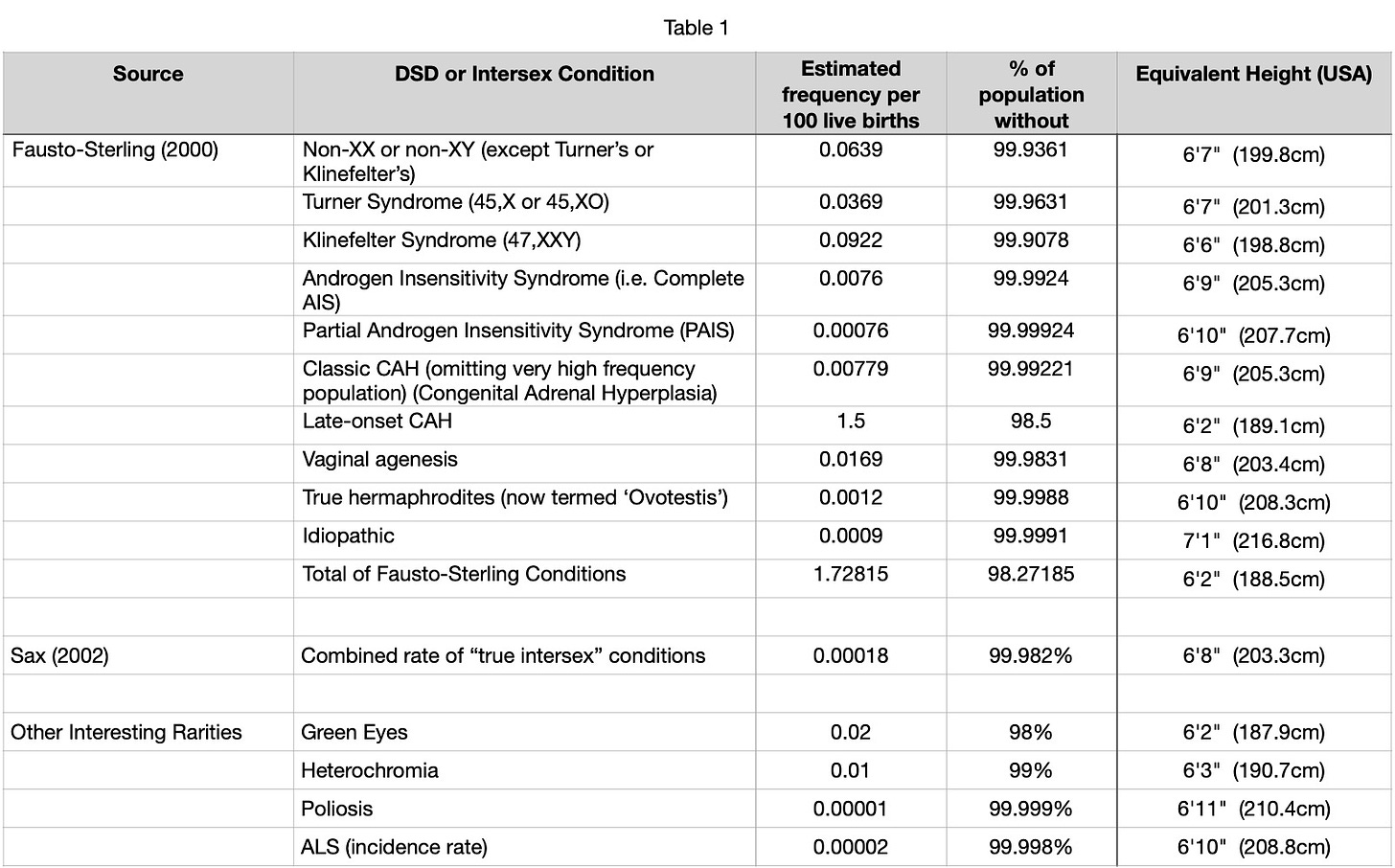From the PITT Substack:
As a parent of a trans identifying kid I frequently find myself arguing with people about the logic of transgender ideology. One of the frequent lines of argument is the “But what about Intersex people? They prove that sex/gender isn’t a binary” and frequently followed by a version of “There are more intersex people than you think and they need a safe non-binary category.” And then there are the claims that intersex conditions are as common as people with red hair.
One of the things I’ve learned about people – and statistics – is that most people are very bad at comprehending numbers, especially very small probabilities. This is why people buy travel insurance and lottery tickets. Its really hard for people to understand just how uncommon something is when the probability is expressed as “.15 per 100,000”. So instead of disputing the true rate of intersex, allow me to convert these rates into something that is more easily comprehended – the height of people.
I started with a CDC dataset of administered height measurements of about 57,000 Americans over the age of 18. The sample is about equally split between men and women and is representative of regions, age, ethnicity etc. It is also extremely gratifying that the distribution of height is indeed a classic Gaussian Normal Distribution – this is nice because most things in nature are normally distributed and because it validates the statistical extrapolation I’m about to do.
For the statistically uninitiated, the normal distribution is a classic bell curve with some very nice properties. In this instance, about 95% of people have a height that is between 4’10 and 6’2” (147cm and 187 cm) and we can easily use something called a Z-score to determine the probability of a person having a height above (or below) any particular height. So you’re 5’10” (~178 cm), that’s 1.08 standard deviations from the mean which means you are taller than just about 86% of the US adult population. As we move away from the average or middle of the curve the frequency becomes very “thin”, so small increase (or decreases) in height have dramatically different probabilities! For instance, a person of average height is, by definition, taller than 50% of the population but being just one inch taller makes you taller than just about 60% of the population, an increase of 10%. Contrast that with the “thin” tail where moving from a height of 6’3” to 6’4” (also a gain of just one inch) moves from being taller than 98.9% to taller than 99.4% , an increase of just .5%.
Now let’s convert intersex occurrence rates! The pro-gender/sex spectrum community likes the numbers from Sterling et al, which sets the rate of intersex conditions at 1.78% (this seems to be the source of the “common as redheads” idea). Sax makes a really strong argument that the Sterling numbers grossly overestimate the intersex rate, lowering it from 1.78% to .018%, or about 100 times lower. Colin Wright has an excellent and approachable article supporting Sax’s position. I’ll leave the discussion of what really constitutes “true intersex” to others and focus just on demonstrating the occurrence rate in a more meaningful way. What I’ve done is take the “% per 100 live births” and convert it into the % of people who don’t have the condition – which I personally find changes the direction of the perspective to be more useful. I then take that percentage and find how tall a USA adult would have to be to have the same occurrence rate.
Looking at the table, what the height roughly represents is that the probability of a person being “Non-XX or Non-XY” is the same as you rolling out of the house and finding a person taller than 6’7.2” (201cm). As you go down the list of supposedly “common” conditions note how many people you know – or might even see during your day – who are taller than 6’2.5” (the most common, not at-birth, and not an intersex condition of Late Onset CAH). The least common condition, Idiopathic, corresponds to a giant 7’1”(~217cm). The Sax figure for overall intersex conditions corresponds to a height of 6’8” (198cm). Unless you routinely hang around basketball teams you are very unlikely to see someone this tall! Indeed, over the entire history of the NBA, players average just under 6’6” (198cm) so you would need to find an above-average height basketball player! This also holds for players since 2000, for whom the average height is 6’7”.
For further comparison, I’ve added in some other rare traits of humans: green eyes, heterochromia (different colored eyes), poliosis (patches of gray hair), and the probability of being diagnosed with ALS.
These numbers are less specific because it just isn’t that life-changing if you have green eyes so the counting isn’t as careful.
Hopefully this height comparison
effectively illustrates how rare these conditions are. But we can stretch the example a bit more: Both really tall and intersex people exist – as do people with green eyes and gray hair patches. However the presence of really tall (and short!) people doesn’t change the fact that the average US adult is 167cm tall, nor does it change the fact that women have an average height of 5’3” (160cm) and men 5’8.5” (174 cm). Similarly, the existence of intersex conditions doesn’t change the fact that humans are sexually dimorphic.
Extending this comparison – an adult’s height is fixed and so the presence of remarkably taller or shorter people really doesn’t have an affect on us. The fact that there are people who are 7’ tall doesn’t affect our height, our interactions with the world or our interactions with 99.999% of other people. Similarly, the presence of some people with DSDs of intersex conditions doesn’t affect our understanding of our bodies. The gender expansive attempts to spin intersex conditions into a sexual spectrum is akin to requiring all of our chairs, cars, doors, showers and clothing fit people who are taller than the rare “average” NBA professional.
Clearly, intersex people and the really tall deserve more than a place in a circus freak show (and shower heads that are mounted high enough) but we also shouldn’t classify either group as “normal” in the sense of being representative of the population. The next time someone says “But what about Intersex people?” just reply – “Well yeah, but what about the needs of everyone 6’8” and taller? You need to refit your shower, doorways and guest bed to accommodate that person just in case one comes to stay with you” and see what happens.
The author has a teen working through trans identity, is taller than 99.46% of the US population and finds that showers are too short, car seats and plane seats are just wrong and no one seems to care.

Yes, I could have done the “shortness” of people as well. But because tall people stand out more than short people – for obvious reasons – and because I’m tall I went with height.
The ALS number is a little different … people with green eyes just have green eyes and they continue to have green eyes. People diagnosed with ALS live about three years after the diagnosis, so this is the probability that a given person will be diagnosed with ALS this year.
A Note on Comparability: I’m very clear that these numbers are relevant only in the United States. Trying to make these height comparisons in other countries would require considering the local distribution of height. For instance, by one measure the USA ranks only #52 for average height (at 5’7”/170.1cm) while the Dutch come in #1 (at 5’9.5”/177.1cm) – and the odds of finding a person who is 198cm in Holland are much more likely than in the US! Its also interesting to note that the rates of intersex/DSD conditions are not global, with some populations experiencing much higher rates, so just like height some communities will have fewer or more occurrences of intersex conditions than average.















